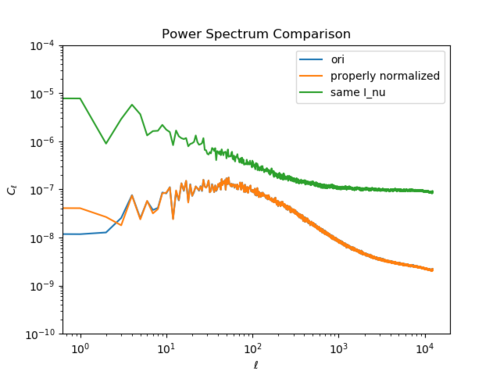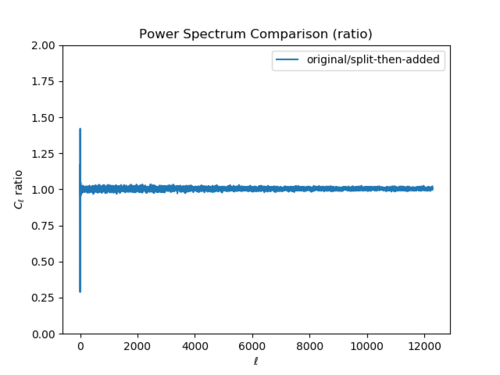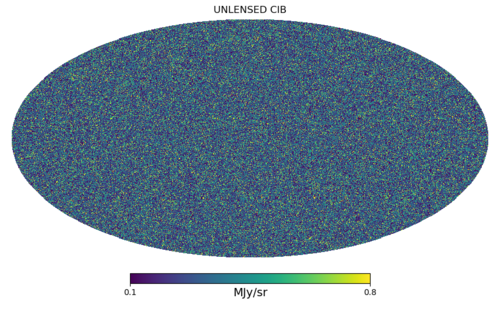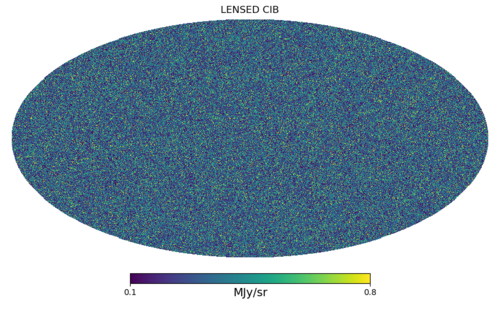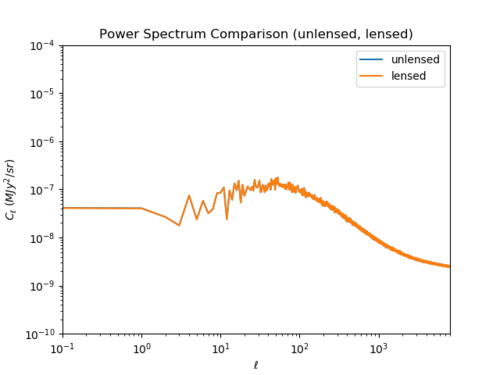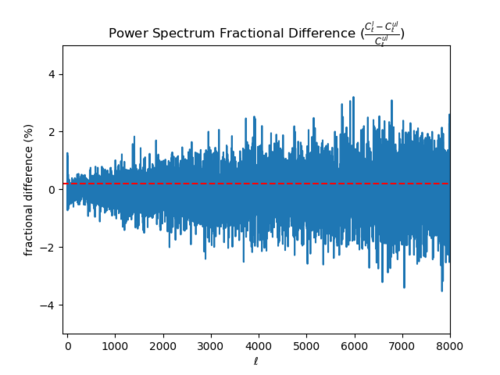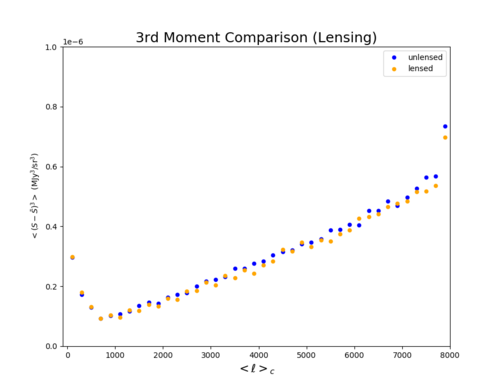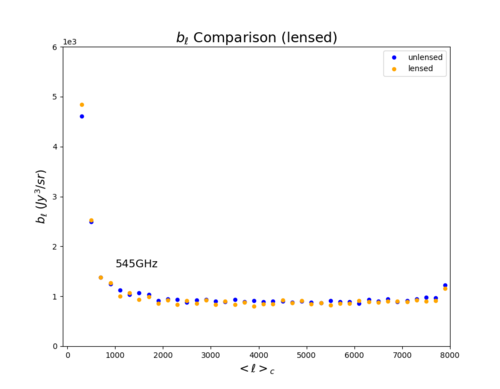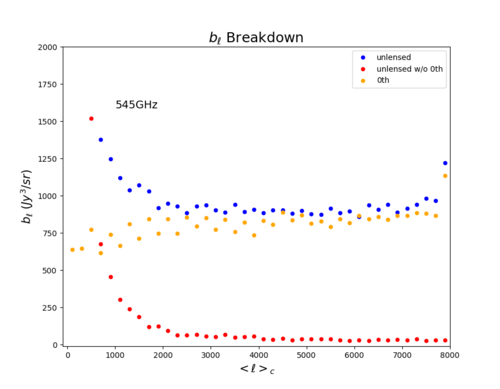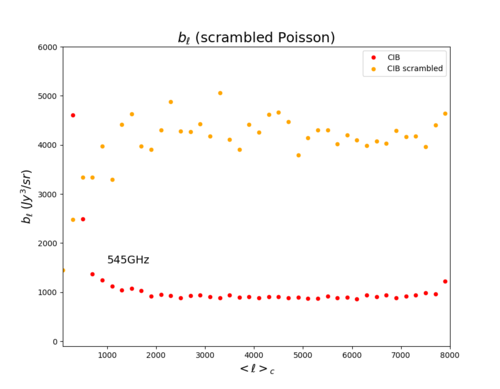June 27th, 2019 - CIB Lensing: Basic Analysis (545GHz)
In this post, I will give a brief (preliminary) analysis of the lensing and its effect on the CIB.
Although we only have the halo-only kappa for now, this still may be meaningful as the halos in the CIB now go to lower masses ([math]\displaystyle{ 10^{12} }[/math] solar masses). The minimum halo mass for the kappa is [math]\displaystyle{ 10^{11} }[/math] solar masses.
I generated 20 shells of the CIB from z = 0.0 to 4.5 (in terms of comoving distance chi, this is 0 to 7600Mpcs); Shell 0 from 0 to 100 Mpcs, Shell 1 from 100 to 400 Mpcs, Shell 2 from 400 to 800 Mpcs, and so forth (in increments of 400Mpcs). I was originally intending to discard Shell 0 since the shell at very close distances caused trouble for us in the past.
The halo kappa generated goes from chi min of 100 Mpcs to chimax = 400 with chisource = 600 (kappa 1), chimax = 800 with chisource = 1000 (kappa 2), and so forth (again, the two parameters ascending by 400Mpcs) (I am wondering whether setting chi min to a value closer to zero would be more accurate).
Consequently, I lensed CIB Shell 2 with kappa 1, Shell 3 with kappa 2 up to Shell 19 with kappa 18.
I then added the lensed shells and CIB Shell 0 and 1 together to obtain the lensed CIB map.
I will start out with the sanity check on the split-then-added CIB I sent around in the e-mail yesterday.
Power Spectrum Sanity Check (One Shell vs. 20 Shells)
The 'ori(ginal)' CIB is the CIB generated as one large shell from z = 0.0 to z = 4.5, while the split-then-added CIB is the one split into 20 shells (as above), then added back together. Unsurprisingly, we see that their power spectra match very well except at very low ell.
Unlensed and Lensed CIB Maps
Now we take a look at the maps of the unlensed and lensed; the means of the (pixels of the) maps were virtually the same at around 0.333 MJy/sr. But if the two maps are configured in two different tabs, one can go back and forth to compare their differences. The lensed map (right) looks like a smeared version of the unlensed (left).
Effect of Lensing on Power Spectrum
As expected, lensing does not really affect the CIB power spectrum. Even when the fractional difference ([math]\displaystyle{ \frac{C_{\ell}^{\text{lensed}}-C_{\ell}^{\text{unlensed}}}{C_{\ell}^{\text{unlensed}}} \times 100 }[/math] in (%)) is plotted, the difference is tiny; the average fractional difference (red dashed line) is around 0.06%.
Effect of Lensing on the 3-point function
The effect of gravitational lensing on the 3-point functions (3rd Moment or bispectrum) doesn't seem to be large, but certainly is evident compared to the power spectrum. In both plots, the lensed values are slightly smaller overall. In the plot below, I have the fractional difference of [math]\displaystyle{ b_{\ell} }[/math], where the average drop for [math]\displaystyle{ 0 \lt \ell \lt 8000 }[/math] is 3.3% (red line).
Zeroth Shell Contribution to the 3-point function and Lensing Without It
Yesterday, I discovered that the vast majority of the CIB bispectrum seems to be coming from the tiny 0~100 Mpcs shell. To verify this, I first plotted a breakdown of the unlensed CIB bispectrum; the orange curve (0th) is the bispectrum of 0 ~ 100 Mpcs while the red curve (w/o 0th) is the bispectrum of 100 ~ 7600 Mpcs.
The contribution of the CIB without the first 100 Mpcs on the bispectrum falls rapidly from [math]\displaystyle{ \ell \approx 500 }[/math] and by [math]\displaystyle{ \ell \approx 5000 }[/math], the contribution (somewhere around 30 [math]\displaystyle{ Jy^3/sr }[/math] out of 900 ) hovers around 3%. Conversely, the clustering part ([math]\displaystyle{ \ell \lt 600 }[/math]) of the bispectrum does not seem to be coming primarily from the 0th shell.
Since the 0th (and 1st) CIB Shell is not lensed, I also plotted how the lensing affects the bispectrum between 100 ~ 7600 Mpcs; the difference is now bigger than before (I have not calculated the fractional difference for this yet).
Scrambled Not Matching
I also managed to run Marcelo's scrambling implementation (by reading in the halo catalog in 24 "chunks" rather than 16 as previously); while the bispectrum and 3rd moment follows a similar trend to the original CIB, the magnitude is several times (around 4) larger than the original, which is puzzling (when we scrambled the galaxies, it was 2.5 times smaller). I will have to take a deeper look into this.
